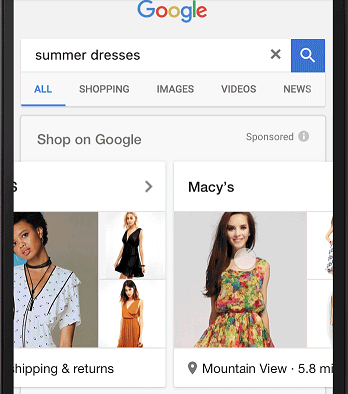Broad, un-branded product searches - such as "women's dresses" - represent 40% of product queries, and now Google has introduced a new ad format for just this type of search: Showcase Shopping ads! Where standard ads previously wouldn't trigger for such broad terms, Showcase ads have been made to be very visual and interactive for broad product queries. Both the standard and Showcase Shopping ad formats are very different from each other, and serve different purposes on Google. Moreover, Showcase Shopping ads are only available in the latest AdWords interface.
How are Showcase Shopping ads different?
The ads are led by a main image which is most relevant to the user's search term, and is accompanied by two smaller images on the side. Beneath the image, you can either add a promotional message or the distance to the nearest store (available for advertisers using Local Inventory Ads). The ads are shown in a carousel format, allowing the user to scroll through the various products.
The first click is free and only expands the ad to a landing page which is still within the search engine, and the advertiser only pays when the user clicks through to the retailer's site. As such, the new format represents a great opportunity for free brand exposure on broad, generic search terms such as "watch", "shoes" or "t-shirt".
Measuring Showcase Shopping ads
While the new ad format is still in its early days, we expect it to drive improved awareness for brands (rather than conversions); the ads will show for very general terms rather than specific products, and very much focus on the user's browsing experience while allowing them to discover your brand when searching for general terms. The format is also very interactive, so it's important to keep in mind engagement metrics as main KPIs. Especially with the first click (the expansion of the ad in the search engine) being free, this format is a great way to generate free exposure, and the focus should be on using it to generate awareness rather than generating sales.


